
Even as the Grenning Gallery in Sag Harbor continues to serve as an East End bastion of the primacy of painterly realism and representational art over more abstract approaches, it has nevertheless recently stretched its curatorial boundaries well past its previous dedication to exhibiting solely contemporary classical drawing and painting.
As a result, while still highlighting artists such as Jimmy Darrell Sanders, whose works reverberate with echoes of Flemish Renaissance painters in his use of paint and light, the gallery has expanded its artistic vision to include painters such as James Daga Albinson, whose more gesturally spontaneous and impressionistic figurative work actually derives from his own earlier dedication to academic techniques.
Showing mostly recent landscapes of predominantly East End scenes, Mr. Albinson begins the paintings on site but then reworks them afterward, thereby creating equilibrium between the spontaneity of plein air technique and the more thoughtful opportunities that retrospection can yield in the studio later on. Within the works, this allows for the reflection of the immediacy of the moment, with its constantly shifting moods and changing balances between light and shade, while still leaving space for artistic intent and the ability to alter reality to illustrate as much what is perceived later as what was actually seen at the time.
This process also allows for the artist’s earlier academic tendencies to find their way into the work, by facilitating the pictorial emphasis on various classical sensibilities, such as true perspective and dramatic foreshortening. This is particularly apparent in works like “Georgica Pond, View to the East” and “Sky Over Sag Harbor Bay” in which the majestic sweep of the clouds toward the horizon almost mathematically defines space and depth, both of which are further emphasized by the subtle transition of color and light far into the distance.
Interestingly, the work that superficially seems best to exemplify Mr. Albinson’s more classical tendencies is actually the most immediate and spontaneously painted piece in the exhibition. Titled “Portrait of David” (2008) and featuring a significantly larger than life-size image of Sag Harbor artist David Slater, the work was done in one session, yet there is, within the subject’s face, a measure of directness and emotional connection that seems more a product of thoughtful reworking than the more impulsive process from which it emerged.
For Jimmy Darrell Sanders, by contrast, impulse would seem to be a rather foreign component in the process of creation. Instead, working from a series of finely tuned preparatory drawings, Mr. Sanders is able to re-create an image that goes much deeper than the merely superficial representation of a standard still-life. Rather, combining masterful draughtsmanship skills that highlight a remarkable comprehension of figure, line and color married to an accomplished approach to light and compositional structure, the works are memorable for the way that they transcend two dimensions and seem to become real, rather than simply idealized pictures of reality.
In “Three,” for example, the structural simplicity of the still-life arrangement at first completely dominates the compositional framework, until one becomes aware of a slight imperfection in the wall behind the central images. Along with subtle shadowing, this flaw further underscores a sense of depth while altering the balance within the work, in that one is offered a visual counterpoint to the gentle circular structure of the form, line and light that comprise the central objects within the picture itself.
This effect is also apparent in “Carpenter’s Tool Belt,” in which the circular arrangement of forms in the center of the canvas is powerfully juxtaposed by the pictorial verticality of the wood grain board on which the tools hang. Matched with the artist’s enviable attention to detail and nuance, the work is powerful for both its rhythmic composition and its remarkable use of painterly perspective.
The impact and import of classical perspective in Mr. Sanders’s work is most apparent, though, in a construction titled “Jimmy Sanders’s Studio, Florence, 2007” and which re-creates the little known 17th century Dutch Renaissance object known as a “Perspective Box” or “Peepshow.”
Consisting of an open rectangular box painted on the inside, the peepshow allowed for the creation of an anamorphic image in which the picture, painted on the inside of the box with one side open, is stretched beyond recognition and only appears completely normal when viewed through peepholes on either side of the box.
The exhibition at the Grenning Gallery in Sag Harbor featuring works by James Daga Albinson and Jimmy Darrell Sanders continues through April 18.